story by Jamie Rector and Kayte Deioma, photos by Jamie Rector
A downpour somehow seems an appropriate accompaniment to the glorious and gritty soul of Motown, which produced such hits as “I Wish it Would Rain” and “Tears of a Clown.”
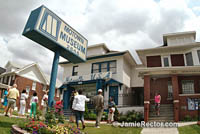 The Motown Historical Museum is one of the more popular tourist attractions in Detroit, though you wouldn’t necessarily know it from its location. About 15 minutes from downtown, past an old hospital, in a semi-residential, semi worn-down area, stand the modest buildings of Motown and Hitsville USA. The street in front is lined with tour buses. The two clean and restored houses that comprise the museum were the studio and office area of the Motown Record Corporation from 1959 to 1972 when it moved to Los Angeles. Signs point the way to the visitor entrance.
The Motown Historical Museum is one of the more popular tourist attractions in Detroit, though you wouldn’t necessarily know it from its location. About 15 minutes from downtown, past an old hospital, in a semi-residential, semi worn-down area, stand the modest buildings of Motown and Hitsville USA. The street in front is lined with tour buses. The two clean and restored houses that comprise the museum were the studio and office area of the Motown Record Corporation from 1959 to 1972 when it moved to Los Angeles. Signs point the way to the visitor entrance.
Making Musical History
Berry Gordy, Jr. started his fledgling record label with an $800 loan from his family. When he bought the first house on West Grand Boulevard in Detroit in 1959 and dubbed it Hitsville USA, he planned to apply the same philosophy to making hit records that the Ford Company applied to producing cars. Starting with Smoky Robinson and the Miracles, Gordy staffed his hit factory with a talented assembly line of song writers, arrangers, house musicians and front line talent to create the unique sound that became known as Motown. The company grew to occupy eight houses on West Grand before moving the headquarters to downtown Detroit and later, Los Angeles.
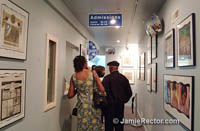 Just past the friendly guard, a long hallway filled with historic photographs welcomes visitors to the home of funk. All the main players are there: Smokey Robinson, Stevie Wonder, The Jackson Five, Diana Ross and many other familiar faces.
Just past the friendly guard, a long hallway filled with historic photographs welcomes visitors to the home of funk. All the main players are there: Smokey Robinson, Stevie Wonder, The Jackson Five, Diana Ross and many other familiar faces.
Tours run continuously, beginning as soon as they have enough people to start. After a brief introduction, and strict instructions to keep the cameras put away, the tour guide walks the group through a series of rooms with more classic photos of legends in their hey day, as well as original record covers, memorabilia, and gold records. The exhibit also includes stage costumes worn by Motown artists including Michael Jackson’s original hat and white sequined glove.
The Michael Jackson memorabilia was once stolen right out the museum. There was no case around it at the time. It didn’t take much clever sleuthing to find the thief. The day it was stolen, there was only one guest – and he signed the guestbook, complete with address. They tracked him down and got the items back. They were so happy to have the pieces back they didn’t even bother to press charges.
The living room, dining room and kitchen of what used to be Berry Gordy’s apartment, is restored to its 1959-60 appearance. Some of the original furniture remains, so it can be seen just the way it was. It is roped off, so you can look but not touch.
After this glimpse into daily life in the Motown house, the tour moves to the backbone of the Motown business – the office where it all began and where artists were signed. There are original notes and paperwork in the office giving it the feel that you have stepped back in time.
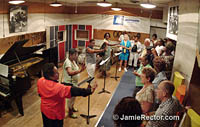 Adjacent to the office is the control room and the recording studio. The piano and drum set stand ready for the house band, the Funk Brothers, to walk in and start playing. Having all the singing groups record with the same backup band created that consistency of sound that is so Motown. Although largely unknown as individual musicians, the story of the Funk Brothers’ contribution to the Motown sound has recently been told in the documentary, Standing in the Shadows of Motown. In addition to Funk Brother Earl Van Dyke, the piano was also played by Marvin Gaye and Stevie Wonder, who both broke the Motown assembly line mold by being songwriters, musicians and singers.
Adjacent to the office is the control room and the recording studio. The piano and drum set stand ready for the house band, the Funk Brothers, to walk in and start playing. Having all the singing groups record with the same backup band created that consistency of sound that is so Motown. Although largely unknown as individual musicians, the story of the Funk Brothers’ contribution to the Motown sound has recently been told in the documentary, Standing in the Shadows of Motown. In addition to Funk Brother Earl Van Dyke, the piano was also played by Marvin Gaye and Stevie Wonder, who both broke the Motown assembly line mold by being songwriters, musicians and singers.
You can’t sit at the famous piano, but you might get a chance to stand where icons like Smokey Robinson, the Temptations, the Four Tops and Diana Ross and the Supremes stood to record their chart-smashing hits – an experience not to be missed.
Motown Historical Museum
2648 W. Grand Boulevard
Detroit, Michigan 48208
(313) 875-2264
www.motownmuseum.com

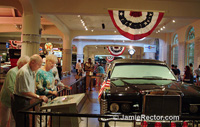 You could be there all day and not see everything. You might expect a museum named for Henry Ford to be all about cars, and there are plenty of exhibits on the development of the automobile. But the majority of space if given over to what began as Henry Ford’s collection of the evidence of American ingenuity in technology and ideas. Ford’s vision included collecting and preserving the objects in people’s daily lives as a way of documenting American history. Throughout the museum and the adjacent Greenfield Village, are mementos from the people Ford cared about as well as things that attracted him. He has Thomas Edison’s last breath contained in a small vial as well as some authentic and replica pieces of his best friend’s life.
You could be there all day and not see everything. You might expect a museum named for Henry Ford to be all about cars, and there are plenty of exhibits on the development of the automobile. But the majority of space if given over to what began as Henry Ford’s collection of the evidence of American ingenuity in technology and ideas. Ford’s vision included collecting and preserving the objects in people’s daily lives as a way of documenting American history. Throughout the museum and the adjacent Greenfield Village, are mementos from the people Ford cared about as well as things that attracted him. He has Thomas Edison’s last breath contained in a small vial as well as some authentic and replica pieces of his best friend’s life.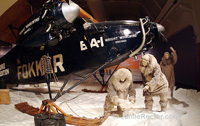 In the Automobile in American Life exhibit, there are antique vehicles, test cars that never made it into the market, race cars and automobiles developed through the 20th century. There are also icons of American life that developed because of the more mobile lifestyle brought on by ease of transportation such as roadside diners and fast food restaurants. Other exhibits showcase the history of other modes of transportation from the stage coach to the locomotive to the airplane.
In the Automobile in American Life exhibit, there are antique vehicles, test cars that never made it into the market, race cars and automobiles developed through the 20th century. There are also icons of American life that developed because of the more mobile lifestyle brought on by ease of transportation such as roadside diners and fast food restaurants. Other exhibits showcase the history of other modes of transportation from the stage coach to the locomotive to the airplane.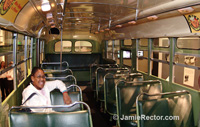 In 2006, the Henry Ford introduced a new exhibit called With Liberty and Justice for All. It includes artifacts from the American Revolution through the civil rights movement. You can only look at Abraham Lincoln’s chair form the Ford Theatre where he was shot and George Washington’s camp bed, but you can climb on the restored Montgomery City Lines bus and sit in the seat where Rosa Parks sat and changed the world.
In 2006, the Henry Ford introduced a new exhibit called With Liberty and Justice for All. It includes artifacts from the American Revolution through the civil rights movement. You can only look at Abraham Lincoln’s chair form the Ford Theatre where he was shot and George Washington’s camp bed, but you can climb on the restored Montgomery City Lines bus and sit in the seat where Rosa Parks sat and changed the world.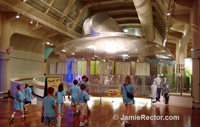 The Henry Ford has also restored the only remaining example of Buckminster Fuller’s Dymaxion House, a round, aluminum dwelling that was designed in 1946 to be inexpensive, easy to assemble and sturdy enough to withstand tornados. Your Place in Time has common everyday items identified by the generation that grew up with them, from the Progressives and War Generation through the Baby Boomers to the Gen Xers and the Next Generation. Other exhibit subjects include agricultural technology, silver and pewter, clocks, home arts and furnishings.
The Henry Ford has also restored the only remaining example of Buckminster Fuller’s Dymaxion House, a round, aluminum dwelling that was designed in 1946 to be inexpensive, easy to assemble and sturdy enough to withstand tornados. Your Place in Time has common everyday items identified by the generation that grew up with them, from the Progressives and War Generation through the Baby Boomers to the Gen Xers and the Next Generation. Other exhibit subjects include agricultural technology, silver and pewter, clocks, home arts and furnishings.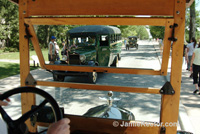 Outside the main museum, Greenfield Village covers 90 acres of the Ford Estate. It is the oldest and largest living history museum in the country. Much of it is outdoors, so an umbrella might come in handy, but there are tours in vintage Ford vehicles that will drive you through the village pointing out various buildings, including the 1929 Martha May Chapel, an English Cottage, a windmill and a clock shop built as a school. Of the 63 structures, 42 were brought here and 21 are replicas. Many of them have interior exhibits with staffed by costumed reenactors.
Outside the main museum, Greenfield Village covers 90 acres of the Ford Estate. It is the oldest and largest living history museum in the country. Much of it is outdoors, so an umbrella might come in handy, but there are tours in vintage Ford vehicles that will drive you through the village pointing out various buildings, including the 1929 Martha May Chapel, an English Cottage, a windmill and a clock shop built as a school. Of the 63 structures, 42 were brought here and 21 are replicas. Many of them have interior exhibits with staffed by costumed reenactors.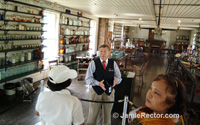 Structures related directly to Henry Ford include his actual boyhood home and replicas of his Bagley Avenue Workshop where he built his first “quadricycle” and a one quarter size replica of his first factory. Ford’s tribute to his friend Thomas Edison include Edison’s Fort Meyers Florida laboratory and replicas of his laboratory, glass shed, machine shop, office and library in Menlo Park New Jersey. The Village includes a Main Street with traditional trades and crafts and historic eating establishments and side streets with the homes, porches and parlors of historic individuals. There are also a number of working farms, mills and a railroad junction with train rides.
Structures related directly to Henry Ford include his actual boyhood home and replicas of his Bagley Avenue Workshop where he built his first “quadricycle” and a one quarter size replica of his first factory. Ford’s tribute to his friend Thomas Edison include Edison’s Fort Meyers Florida laboratory and replicas of his laboratory, glass shed, machine shop, office and library in Menlo Park New Jersey. The Village includes a Main Street with traditional trades and crafts and historic eating establishments and side streets with the homes, porches and parlors of historic individuals. There are also a number of working farms, mills and a railroad junction with train rides.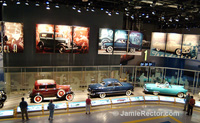 Another part of the Ford extravaganza is The Rouge Tour. A tour bus picks you up and drops you off right in front of the Ford Museum. It is an off site tour of the cars being made in Ford’s Rouge Factory, named for the Rouge River running beside it. There is a multi media introduction that gives a multi-sensory idea of some of the history with seven gigantic screens and chairs that swivel 360 degrees and shake below you. Hot air blows on you; strobes flash. It’s a dramatic display – almost too much.
Another part of the Ford extravaganza is The Rouge Tour. A tour bus picks you up and drops you off right in front of the Ford Museum. It is an off site tour of the cars being made in Ford’s Rouge Factory, named for the Rouge River running beside it. There is a multi media introduction that gives a multi-sensory idea of some of the history with seven gigantic screens and chairs that swivel 360 degrees and shake below you. Hot air blows on you; strobes flash. It’s a dramatic display – almost too much.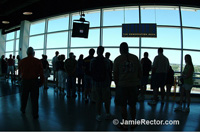 The tour then moves to the observation deck where they show you the world’s largest eco-roof on the top of the Ford building. It is a living, breathing lawn that is used to naturally help keep the building 10 degrees cooler in summer and also warmer in winter. When that part of the tour is over, there’s a self-guided tour around the actual factory. High above the employees, you can walk a circle around the entire top of the plant and watch the cars being pieced together, from frame to windshield wipers.
The tour then moves to the observation deck where they show you the world’s largest eco-roof on the top of the Ford building. It is a living, breathing lawn that is used to naturally help keep the building 10 degrees cooler in summer and also warmer in winter. When that part of the tour is over, there’s a self-guided tour around the actual factory. High above the employees, you can walk a circle around the entire top of the plant and watch the cars being pieced together, from frame to windshield wipers.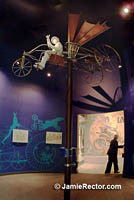 If you haven’t had enough of the auto culture, on the same property as the Ford Museum is the independent Automotive Hall of Fame. This is less a look at how cars are made and more about the people in the world that have had a major impact on the automotive industry in every corner of the world. Every year they add new inductees and celebrate people such as Sakichi Toyoda, founder of Toyota Industries and Soichiro Honda, founder of Hondo Motor Company as well as the dealerships that sold the most vehicles. There are interactive displays where kids or adults can build their own cyber hotrods. It’s not very big, so it won’t take too much time, but it’s a nice supplement to the rest of what Motor City has to offer.
If you haven’t had enough of the auto culture, on the same property as the Ford Museum is the independent Automotive Hall of Fame. This is less a look at how cars are made and more about the people in the world that have had a major impact on the automotive industry in every corner of the world. Every year they add new inductees and celebrate people such as Sakichi Toyoda, founder of Toyota Industries and Soichiro Honda, founder of Hondo Motor Company as well as the dealerships that sold the most vehicles. There are interactive displays where kids or adults can build their own cyber hotrods. It’s not very big, so it won’t take too much time, but it’s a nice supplement to the rest of what Motor City has to offer.